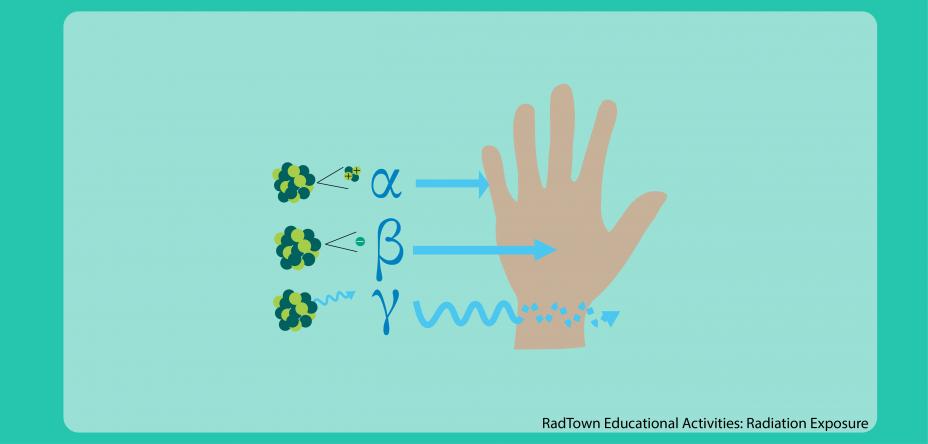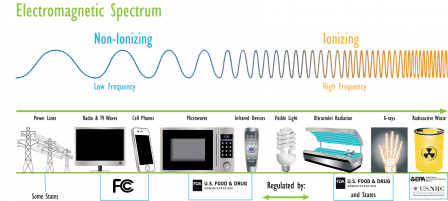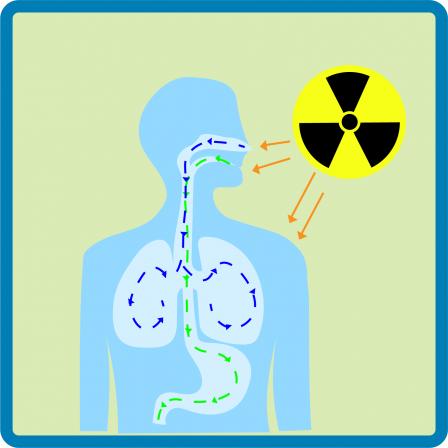RadTown Radiation Exposure: Teacher Information
Radiation is energy that travels in the form of waves and makes up the electromagnetic spectrum. The electromagnetic spectrum is divided into two major categories: ionizing radiation and non-ionizing radiation.
- Background Information for Teachers
- Target Audience and Activity Topics
- Activity Times
- Next Generation Science Standards
- Common Core State Standards
- Additional Resources
Background Information for Teachers
Radiation is part of our daily lives. It is all around us and has been present since the birth of this planet. Two main types of radiation — non-ionizing and ionizing — form the electromagnetic spectrum. We are routinely exposed to naturally occurring (background) radiation that comes from outer space, the sun, the ground, and even from within our own bodies, as well as man-made sources of ionizing and non-ionizing radiation.
Non-Ionizing Radiation
Non-ionizing radiation includes both low frequency radiation and moderately high frequency radiation, including radio waves, microwaves, infrared radiation and visible light. Non-ionizing radiation has enough energy to move around the atoms in a molecule or cause them to vibrate, but not enough to remove electrons.
Non-ionizing radiation is used in many common tasks. We use:
- Microwave radiation for telecommunications and heating food.
- Infrared radiation for infrared lamps to keep food warm in restaurants.
- Radio waves for radio broadcasting.
High frequency sources of non-ionizing and ionizing radiation (such as the sun and ultraviolet radiation) can cause burns and tissue damage with overexposure.
Ionizing Radiation
Ionizing radiation includes higher frequency ultraviolet radiation, x-rays and gamma rays. Ionizing radiation has enough energy to break chemical bonds in molecules or remove tightly bound electrons from atoms, creating charged molecules or atoms (ions).
Ionizing radiation can pose a health risk by damaging tissue and DNA in genes. The amount of damage depends on the type of radiation, the exposure pathway, the radiation’s energy, and the total amount of radiation absorbed. Because damage is at the cellular level, the effect from small or even moderate exposure may not be noticeable. Most cellular damage is repaired. However, some cells may not recover as well as others and could become damaged or cancerous. Radiation also can kill cells.
Sources of Radiation Exposure
The word “radiation” generally brings to mind man-made sources of ionizing radiation such as nuclear power plants, nuclear weapons or medical procedures, tests and treatments. However, we are routinely exposed to:
- Natural (background) radiation including naturally occurring ionizing and non-ionizing radiation sources from outer space, the sun, the ground, and even from within our own bodies.
- Man-made ionizing and non-ionizing sources such as smoke detectors, microwaves, cell phones and electrical power lines.
Exposure Pathways and Contamination
The three basic radiation exposure pathways are:
- Direct or external exposure (radioactive substances coming into contact with the skin).
- Inhalation (breathing radioactive gases, smoke, dust or particles into the lungs).
- Ingestion (eating or drinking substances that contain radioactive elements).
Contamination occurs when a person makes direct contact with, ingests or inhales radioactive materials. Contamination may occur when radioactive materials are released into the environment as the result of an accident, an event in nature or an act of terrorism. After direct contact, people and personal property must be decontaminated.
Penetrating Power of Ionizing Radiation
When radioactive atoms decay, they give off energy in the form of ionizing radiation. The major types of ionizing radiation emitted during radioactive decay are alpha particles, beta particles and gamma rays. Other types, such as x-rays, can occur naturally or be machine-produced.
Alpha particles lack the energy to penetrate even the outer layer of skin, so exposure to alpha particles outside of the body is not a major concern. Inside the body, however, they can be very harmful. If alpha-emitters are inhaled, swallowed, or get into the body through a cut, the alpha particles can damage sensitive living tissue. The way these large, heavy particles cause damage makes them more dangerous than other types of radiation. The ionizations they cause are very close together - they can release all their energy in a few cells.
This can result in severe damage to cells and DNA.
Beta particles are more penetrating than alpha particles but are less damaging to living tissue and DNA because the ionizations they produce are more widely spaced. They travel farther in air than alpha particles, but can be stopped by a layer of clothing or by a thin layer of a substance such as aluminum. Some beta particles are capable of penetrating the skin and causing damage such as skin burns. This can result in severe damage to cells and DNA.
Gamma rays are a radiation hazard for the entire body. They can easily penetrate barriers, such as skin and clothing that can stop alpha and beta particles. Gamma rays have so much penetrating power that several inches of a dense material like lead or even a few feet of concrete may be required to stop them. Gamma rays can pass completely through the human body easily. As they pass through, they can cause ionizations that damage tissue and DNA.
Health Effects of Radiation Exposure
Low frequency sources of non-ionizing radiation are not known to present health risks. High frequency sources of non-ionizing radiation (such as the sun and ultraviolet radiation) can cause burns and tissue damage with overexposure.
Ionizing radiation can damage living tissue by changing cell structure and damaging DNA. The amount of damage depends on the type of radiation, the exposure pathway, the radiation’s energy and the total amount of radiation absorbed.
Children are more sensitive to ionizing radiation than adults because children are still in the process of growing. There are more cells dividing and a greater opportunity for radiation to disrupt the growth process. Recent U.S. Environmental Protection Agency (EPA) radiation protection standards take into account the differences in sensitivity due to age and gender.
How Do We Know Ionizing Radiation Causes Cancer?
The greatest risk from exposure to ionizing radiation is cancer. Much of our knowledge about the risks is based on studies of more than 100,000 survivors of the atomic bombs in Hiroshima and Nagasaki, Japan, at the end of World War II. Studies of radiation industry workers and people receiving large doses of medical radiation are also important sources. Scientists learned many things from these studies, including:
- The chance of developing cancer (not the seriousness or severity of the cancer) increases as the radiation dose increases.
- Cancers caused by radiation do not appear until years after the radiation exposure.
- Some people are more likely to develop cancer from radiation exposure than others.
Target Audience and Activity Topics
The RadTown Radiation Exposure activities are designed to help students understand the properties of ionizing and non-ionizing radiation. With this understanding, students will be able to identify sources of non-ionizing and ionizing radiation in our world. Students will also examine how they may be exposed to ionizing radiation, evaluate the benefits and risks associated with radiation exposure, and identify situations in which they may choose to control or limit their exposure to ionizing radiation. Students will learn about the penetrating powers of different types of radiation and with this knowledge they can correct the myths associated with radiation exposure.
NOTE: The term “radiation” used in the activities generally refers to ionizing radiation unless otherwise indicated.
Activity Times
All U.S. Environmental Protection Agency (EPA) Radiation Education Activities can be used individually or modified and combined to create multiple lessons. Activity options allow you to customize the activities to fit the time you have available (e.g., 1 - 2 class periods) and meet the needs and interests of your students.
The time needed to complete activities is between 45 - 60 minutes, not including optional activities or extensions.
Next Generation Science Standards
The concepts within these activity sets can be used to support the following science standards:
- PS4. Waves and Electromagnetic Radiation
- LS2. Matter and Energy in Organisms and Ecosystems
Common Core State Standards (CCSS)
The concepts in the Vocabulary Activities align with the following standards
- CCSS English Language Arts Standards for Literacy in History/Social Studies, Science, & Technical Subjects:
- CCSS.ELA-Literacy.RST.6-12.2 Key Ideas and Details
- CCSS.ELA-Literacy.RST.6-12.4 Craft and Structure
- CCSS.ELA-Literacy.L.6-12.6 Vocabulary Acquisition and Use
The concepts in the Types of Radiation Activity align with the following standards:
- CCSS English Language Arts Standards for Literacy in History/Social Studies, Science, & Technical Subjects:
- CCSS.ELA-Literacy.SL.6-12.1 Comprehension and Collaboration
- CCSS.ELA-Literacy.SL.6-12.2 Comprehension and Collaboration
- CCSS.ELA-Literacy.SL.6-12.4 Presentation of Knowledge and Ideas
- CCSS.ELA-Literacy.RST.6-12.7 Integration of Knowledge and Ideas
- CCSS.ELA-Literacy.WHST.6-12.1 Text Types and Purposes
- CCSS Mathematics Standards
- CCSS.MATH.PRACTICE.MP1
- CCSS.MATH.PRACTICE.MP2
The concepts in the Sources of Annual Radiation Exposure activity align with the following standards:
- CCSS English Language Arts Standards for Literacy in History/Social Studies, Science, & Technical Subjects:
- CCSS.ELA-Literacy.SL.6-12.2 Comprehension and Collaboration
- CCSS.ELA-Literacy.RST.6-12.7 Integration of Knowledge and Ideas
- CCSS.ELA-Literacy.RST.6-12.4 Craft and Structure
- CCSS Mathematics Standards
- CCSS.MATH.PRACTICE.MP1
- CCSS.MATH.PRACTICE.MP2
The concepts in the Penetrating Powers of Ionizing Radiation activity align with the following standards:
- CCSS English Language Arts Standards for Literacy in History/Social Studies, Science, & Technical Subjects:
- CCSS.ELA-Literacy.SL.6-12.1 Comprehension and Collaboration
- CCSS.ELA-Literacy.SL.6-12.4 Presentation of Knowledge and Ideas
- CCSS.ELA-Literacy.RST.6-12.7 Integration of Knowledge and Ideas
- CCSS.ELA-Literacy.WHST.6-12.1 Text Types and Purposes
The concepts in the Exposure Pathways activity align with the following standards:
- CCSS English Language Arts Standards for Literacy in History/Social Studies, Science, & Technical Subjects:
- CCSS.ELA-Literacy.SL.6-12.1 Comprehension and Collaboration
- CCSS.ELA-Literacy.RST.6-12.7 Integration of Knowledge and Ideas
The concepts in the Radiation Health Effects activity align with the following standards:
- CCSS English Language Arts Standards for Literacy in History/Social Studies, Science, & Technical Subjects:
- CCSS.ELA-Literacy.SL.6-12.2 Comprehension and Collaboration
- CCSS.ELA-Literacy.SL.6-12.4 Presentation of Knowledge and Ideas
- CCSS.ELA-Literacy.WHST.6-12.9 Research to Build and Present Knowledge
The concepts in the Acute versus Chronic Exposure activity align with the following standards:
- CCSS English Language Arts Standards for Literacy in History/Social Studies, Science, & Technical Subjects:
- CCSS.ELA-Literacy.SL.6-12.4 Presentation of Knowledge and Ideas
- CCSS.ELA-Literacy.WHST.6-12.1 Text Types and Purposes
- CCSS.ELA-Literacy.WHST.6-12.9 Research to Build and Present Knowledge
The concepts in the Radiation: Fact or Fiction? activity align with the following standards:
- CCSS English Language Arts Standards for Literacy in History/Social Studies, Science, & Technical Subjects:
- CCSS.ELA-Literacy.SL.6-12.1 Comprehension and Collaboration
- CCSS.ELA-Literacy.SL.6-12.2 Comprehension and Collaboration
- CCSS.ELA-Literacy.SL.6-12.4 Presentation of Knowledge and Ideas
- CCSS.ELA-Literacy.RST.6-12.1 Key Ideas and Details
- CCSS.ELA-Literacy.RST.6-12.2 Key Ideas and Details
- CCSS.ELA-Literacy.RST.6-12.3 Key Ideas and Details
- CCSS.ELA-Literacy.RST.6-12.4 Craft and Structure
- CCSS.ELA-Literacy.RST.6-12.7 Integration of Knowledge and Ideas
- CCSS.ELA-Literacy.WHST.6-12.1 Text Types and Purposes



